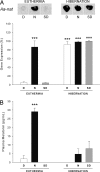The circadian clock stops ticking during deep hibernation in the European hamster
- PMID: 17715068
- PMCID: PMC1959465
- DOI: 10.1073/pnas.0704699104
The circadian clock stops ticking during deep hibernation in the European hamster
Abstract
Hibernation is a fascinating, yet enigmatic, physiological phenomenon during which body temperature and metabolism are reduced to save energy. During the harsh season, this strategy allows substantial energy saving by reducing body temperature and metabolism. Accordingly, biological processes are considerably slowed down and reduced to a minimum. However, the persistence of a temperature-compensated, functional biological clock in hibernating mammals has long been debated. Here, we show that the master circadian clock no longer displays 24-h molecular oscillations in hibernating European hamsters. The clock genes Per1, Per2, and Bmal1 and the clock-controlled gene arginine vasopressin were constantly expressed in the suprachiasmatic nucleus during deep torpor, as assessed by radioactive in situ hybridization. Finally, the melatonin rhythm-generating enzyme, arylalkylamine N-acetyltransferase, whose rhythmic expression in the pineal gland is controlled by the master circadian clock, no longer exhibits day/night changes of expression but constantly elevated mRNA levels over 24 h. Overall, these data provide strong evidence that in the European hamster the molecular circadian clock is arrested during hibernation and stops delivering rhythmic output signals.
Conflict of interest statement
The authors declare no conflict of interest.
Figures



References
-
- Geiser F. Annu Rev Physiol. 2004;66:239–274. - PubMed
-
- Carey HV, Andrews MT, Martin SL. Physiol Rev. 2003;83:1153–1181. - PubMed
-
- Kortner G, Geiser F. Chronobiol Int. 2000;17:103–128. - PubMed
-
- Kilduff TS, Krilowicz B, Milsom WK, Trachsel L, Wang LC. Sleep. 1993;16:372–386. - PubMed
-
- Ruby NF. J Biol Rhythms. 2003;18:275–286. - PubMed
Publication types
MeSH terms
Substances
LinkOut - more resources
Full Text Sources

